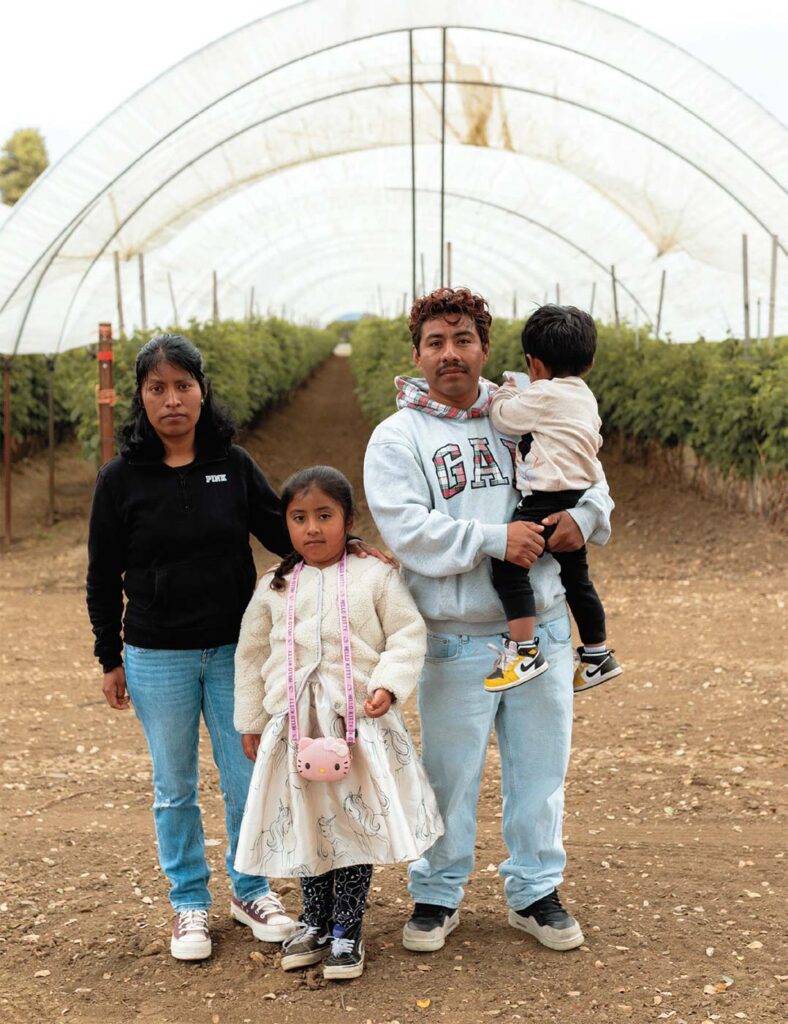
Dolores Huerta stands at a temporary podium on a dirt road in Watsonville, with a farm treated with pesticides on one side, and MacQuiddy Elementary School on the other.
You’d think the juxtaposition would be enough to inspire action, given the links between childhood cancer and chemicals used at the farm, including chloropicrin, malathion and 1,3-dichloropropene.
If that isn’t enough, there’s also the fact Huerta, the 5-foot-tall giant in the United Farm Workers (UFW) movement, still has this self-evident problem to call out.
The moment comes a half century after she launched UFW with Cesar Chavez, and a month after she celebrated her 95th birthday.
“There is no reason [growers] have to use pesticides,” she says. “Organic farmers have proven that you can grow food without it for centuries.”
The gap in reasoning is familiar to the woman who introduced Huerta at the rally, Dr. Ann Lopez.
As Lopez likes to say, “If you’re looking for logic, you’re in the wrong place.”
For decades, Lopez has directed the nonprofit Center for Farmworker Families (CFF).
In the weeks after the rally, she will leverage a milestone birthday of her own (her 80th) for more support of its efforts.
CFF’s cause involves creating awareness of the circumstances farmworker families face, and working to enhance their financial, physical and overall well-being.
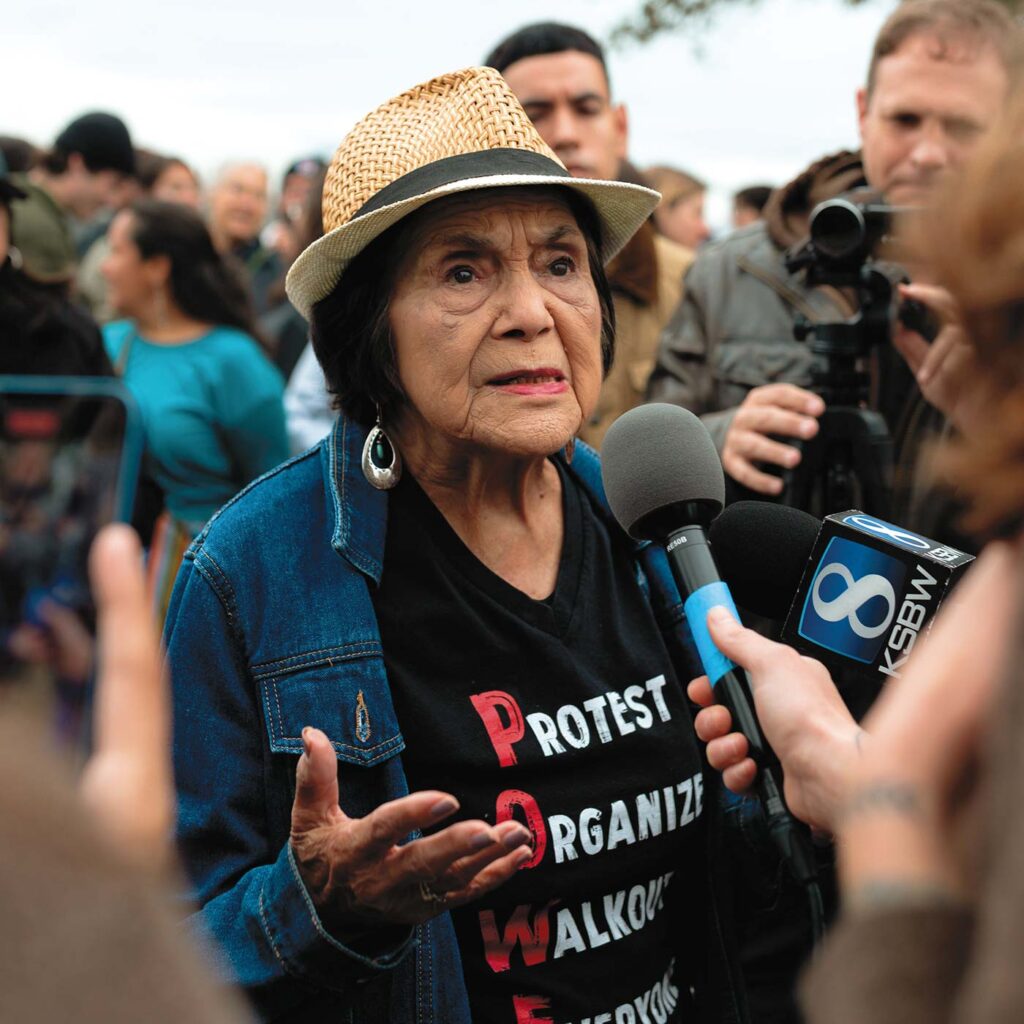
Its avenues to do so include furnishing emergency supplies, rental assistance and educational programs that channel everything from digital literacy to legal rights.
At a Capitola Branch Library lecture this spring, the audience can hear the strain in her voice as she lays out what she calls the “context” for farmworker abuse, namely deregulation, privatization and blaming the poor.
“It’s basically a whole life of deficiency—not enough for food, clothing, housing, education,” she says. “It’s a caste system.”
You can hear the ache as she ticks off the confounding cruelties that pile on top of a physically grueling job: long hours, short pay, extreme weather swings, harassment, exploitation, constant fear of persecution.
“We have to recognize them as human beings who are responsible for our food supply—what’s more important than that?” she asks. “It hurts my soul. They work harder than anyone. The human factor is largely absent.”
And you can feel her fury at what— despite all she’s witnessed—haunts her most.
“The most disturbing part of knowing [the farmworker community] is the incidence of anomalies in children: bone cancer, brain cancer, leukemia, autism, a whole litany of conditions that will affect them their whole life. Almost every household has one kid with an anomaly. How in the world is this allowed? These are children!”
She reiterates many of those points at the start of CCF’s regular Farmworker Reality Tours, public-facing immersions that give farmworkers the chance to be seen and heard.
And offer interested locals the opportunity to listen.
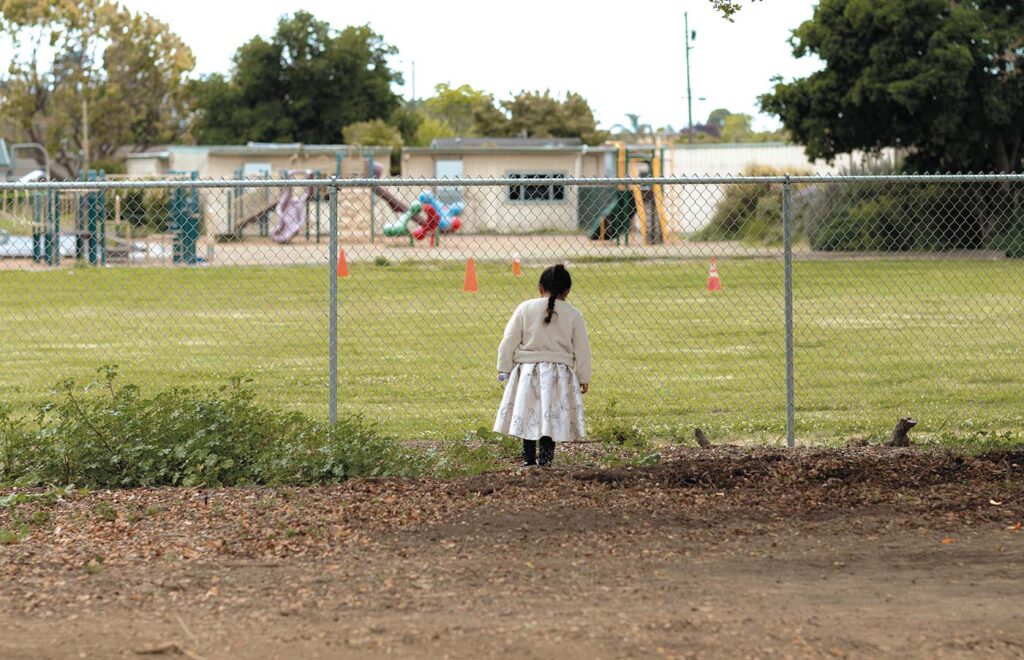
As the most recent tour starts at Crystal Bay Farm in Watsonville, a woman we’ll call Angelina starts speaking softly in Spanish.
She sits in front of the group on a wooden stool, her feet not touching the ground, and apologizes for the blunt strokes of her Spanish, as it isn’t her first language. (Her native dialect is Mixtec.)
A bilingual tour participant, a student of UC Berkeley’s Jesuit School of Theology, volunteers to translate.
Leaving her parents in rural Oaxaca at age 14 was excruciating—“You still need them,” she says—but such was the depravity she faced.
“The dream is to have a better future, not just for me, but my child,” says Angelina, now in her 20s, as her young son taps on a pumpkin by the farm’s raised beds. “I don’t want him to grow up in the same conditions.”
She methodically describes three nights on a bus followed by four nights in the desert with a human trafficker—rattlesnakes’ rattles chasing away sleep, temperature dips that freeze the water in her bottle, an onslaught of scrapes, blisters and bruises capped by collisions with needle-sharp cacti while feeling the way through a moonless night.
“Puro espina,” she says. Pure thorn.
When Angelina, her older brother and the rest of their pod were intercepted by border agents, soaked by recent rains, their limited water and bread well gone, their feeling was relief.
Her brother was so traumatized by starvation and psychosis, he returned home.
Angelina persevered, alone, joining a smothering pile of bodies in the back of a shipping truck across the border, and finding a job despite the double language barrier.
While Angelina’s tenacity reflects unique resolve, concordant refrains follow.
Three more berry workers from nearby Buena Vista Migrant Center (also speaking through the aspiring seminarian) depict wages deferred and stolen; a daughter’s wish to make enough to keep her mother from the fields; and another’s desire to complete a final season—picking from her knees now that her back can’t take it—so she can care for her mom full-time.
When they’re done, Lopez notes the audience looks like they’ve “seen a ghost.”
Dr. Mary E. McGann—an associate professor at the Jesuit School of Theology attending with her students—reports she observed something incorporeal too.
“The motivation and willingness to believe in a future—and do what it takes to have it—is remarkable,” she says. “There’s so much spiritual wisdom that comes with that…we have to look at farmworkers as more than labor. They are gifts.”
“If you’re looking for logic, you’re in the wrong place.”
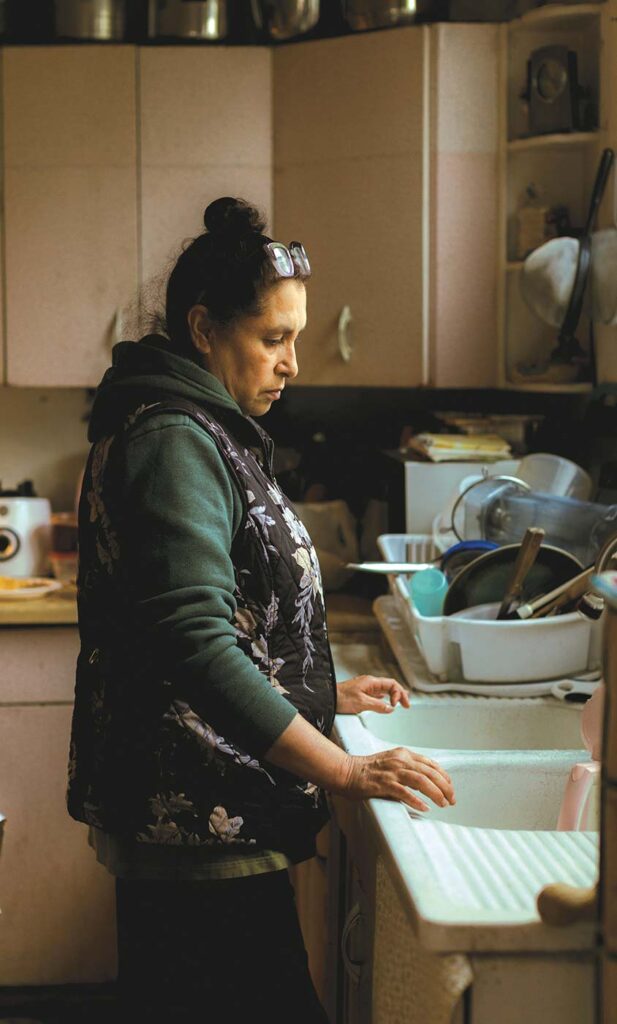
Ernestina’s eyes flash fierce, clear and kind. She sits under a brawny green Japanese maple in her Watsonville backyard, which serves as both a distribution site for Center for Farmworker Families’ vital supplies, and the tour’s closing stanza, starring a meal she preps personally.
She’s had practice describing her circumstances, and making an electric salsa quemada to pour over moist and savory chicken tamales, to pair with hot atole beverages.
But she still gets emotional describing them.
The reason she first came from Michoacan in 1993: a better life for her mom, who raised her without electricity, running water, blankets or enough to eat.
“It was a sad poverty,” she says in Spanish.
The reason she speaks out: Campesinos need more information on resources and rights, and their voice deserves to be heard, unintimidated into accepting subhuman conditions.
“We’re not taking advantage of the system, we’re paying taxes,” she says. “We’re trying to make a change for ourselves, and we’re putting in our part working the harvest.”
The reason criminalizing migrants insults logic: “People who have education and opportunity don’t want to do this—would you?—and maybe they can’t. Because it’s hard.”
The widowed mother of four will share more of that story at the rally before Lopez and Huerta speak, including how she worked the fields while pregnant with her youngest two children, who now suffer with learning disabilities and schizophrenia.
“If I had known there were chemicals in the field,” she says, “I never would’ve worked there. My lack of knowledge, then, is carried by my children, now.”
From there she pivots to empowerment.
“I ask the farm owners to have a conscience, and think about the kids, who are our future,” she adds. “Change is possible. In unity, there is strength.”
Wendy Gabbe Day, a Santa Cruz resident, Food As Medicine event director and mother of two kids, felt the impact of the tour in real time.
“I had no idea what was happening in our own backyard,” she says. “So to hear the stories…I got chills—people doing the work, learning how they got here…the pain involved in the process…how close it all is to our homes.”
Gabbe Day was so moved she signed on to volunteer with vital supply distribution, and later became CFF’s development director.
“I wish we could introduce the tour to every college,” she says. “It’s something that will transform the way you see the world.”
Lopez often asks audiences what response they’d expect if pesticide spraying happening near schools in South Santa Cruz County was happening further north.
Gabbe Day has discussed as much with fellow parents.
“It would be crazy how noisy and infuriated Santa Cruz parents would get,” she says, “which feels so sad.”
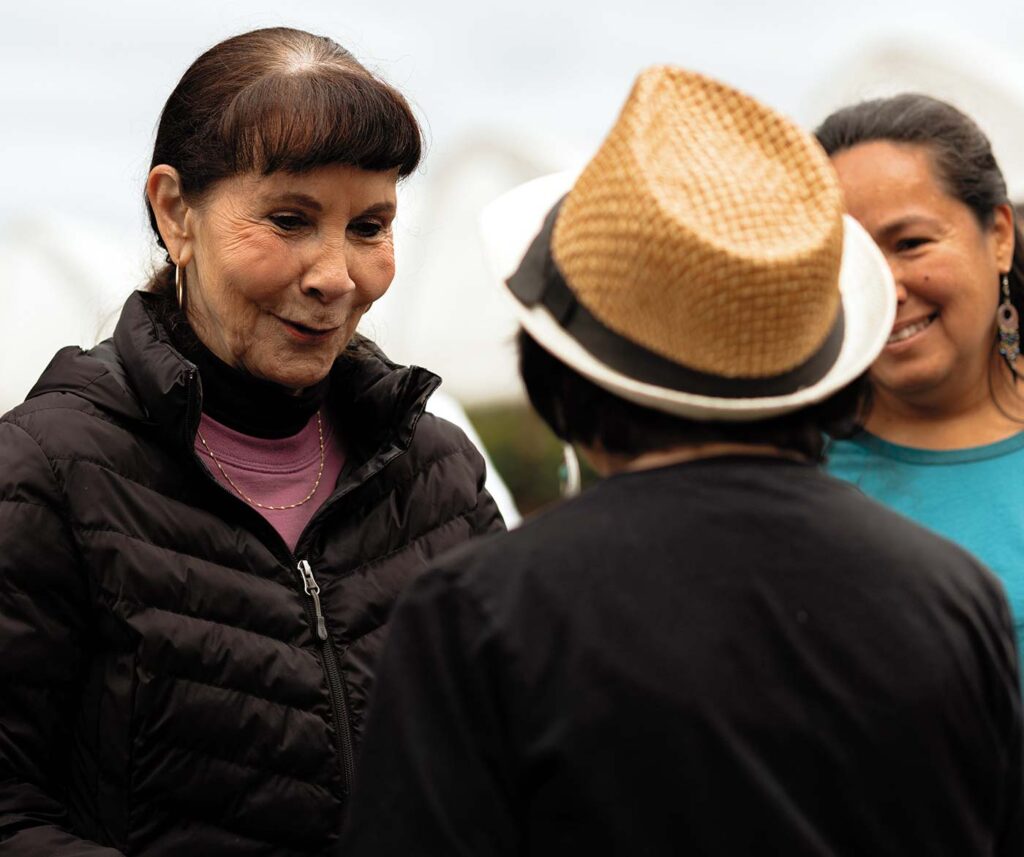
In her position as administrative co-leader of Esperanza Community Farms’ sustainable agriculture advocacy—and a Watsonville native— Mireya Gómez-Contreras is familiar with the problems addressed by Huerta and others on that dirt road in May.
She also feels it’s mislabeled.
Conventional, the adjective used to describe farming that uses pesticides, doesn’t do prevailing practices justice.
“Let’s be truthful,’” she encourages the crowd. “Let’s say, ‘This [non-organic] strawberry is made with poison,’ and ‘I’m not going to eat strawberries made with poison.’”
Gómez-Contreras observes other unhelpful perspectives when it comes to confronting the problem.
“Let’s not talk about how hard it is but how to get there,” she says. “Half of the solution is focusing on the solution.”
She draws from UC Santa Cruz sociology training to help identify patterns across ag sectors, and specifically “pockets of organic farming that are flourishing.”
Thankfully, the list of local organic producers is long, as Adam Scow of the Campaign for Organic & Regenerative Agriculture attests.
“Organic is a model that’s working, and thriving,” he says.
At the rally, Scow calls for Driscoll’s Berries to go organic in the Pajaro Valley, or at least be thoughtful about where its toxic treatments spread.
“What we’re asking for is very modest,” he says. “Our dream is a valley farmed naturally, but what we’re looking at first are plots close to schools,” which number at least a dozen.
He zooms out to tout Driscoll’s potential impact with relatively small local measures, given its global presence in half a dozen countries and $5 billion in annual revenue.
“It’s a reasonable request, considering small independent farmers with slimmer profit margins and more risk have done it,” he says. “Given their distribution network selling to major retailers around the world, if anyone could afford to do it, it’s Driscoll’s.”
“The motivation and willingness to believe in a future—and do what it takes to have it—is remarkable.”
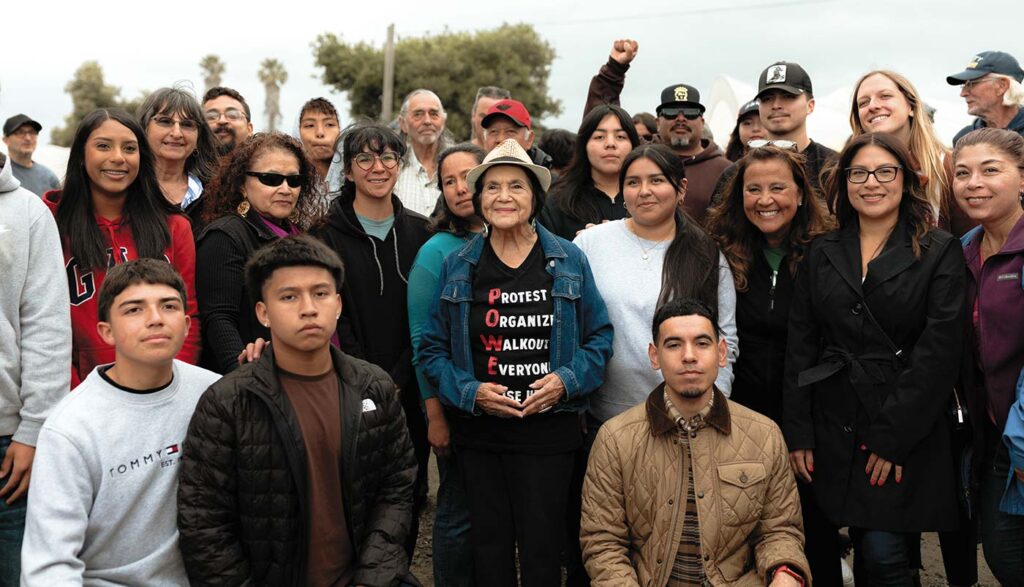
Calls to boycott the biggest berry grower in the region cascade through the rally.
For their part, Watsonville-headquartered Driscoll’s—which, full disclosure, is an Edible advertiser that spotlights its organic division—wasn’t able to connect me with a rep to speak before this issue’s deadline.
A Driscoll’s board member instead directs me to their web page titled, “Driscoll’s Commitment to the Pajaro Valley.”
The statement reads, in part: “Advances take time, research, and investment. But we are committed to leading the way toward more sustainable farming practices. We continue to engage with our independent growers about land management practices that include options to transition some fields into organic production.”
Gómez-Contreras anticipated the reply at the rally—“We keep hearing, ‘It’s too expensive, it’s too difficult,’ but that’s the work, right?”
Cut to Cesar E. Chavez Middle School in Watsonville, at Career Day last March.
Gómez-Contreras speaks with a class of fifth graders, explaining how she loves having a job that—however difficult—affords the chance to confront social problems.
“We need a plan, instead of excuses,” she says later, “with our thoughts not on problems but on solutions. Let’s fall in love with those.”
She didn’t expect to walk away from the classroom as moved as she was after posing a spontaneous question to the class.
The question: Who would like all-organic fruits and vegetables in the cafeteria?
The response: a raised hand from every seat in the room.
When Gómez-Contreras shares that story at the rally, one attendee shouts, “¡Los jóvenes son la esperanza!”
The kids are our hope.
A challenge embeds itself in that cry: Before the kids can save anyone, somebody has to protect them first.

DIGGING IN
Ways you can help protect human and soil health
Some seek to handcuff the hands that feed us, which can be distracting, to put it mildly.
Fortunately, there are positive actions to focus on instead, listed here.
CHECK THE MAP.
The fumigant 1,3-dichloropropene is banned in 34 countries. That’s one of a number of toxins the Campaign for Organic & Regenerative Agriculture (CORA) tracks with colorcoded grids, noting 1 million pounds of pesticides are applied in Santa Cruz County annually, all too often on agricultural fields near schools and homes in the Pajaro Valley.
A seven-panel infographic on CORA’s page at farmworkerfamily.org/cora spotlights the scary-close proximity, which contributes to the county having the second-highest pediatric cancer rates in the state.
TAKE A TOUR.
The homespun Center for Farmworker Families (CFF) voyage moves through organic farms and the Buena Vista Migrant Center, experiences lived and person-to-person interaction.
The insight communicated proves sobering and inspiring, as recent visitor and Jesuit theology professor Dr. Mary E. McGann observes.
”The tour is empowering for those interested in what they can do to help,” she says. “It’s also moving given the incredible sense of courage and endurance the workers—all of them women—convey.”
VOLUNTEER WITHOUT FEAR.
CFF coordinates with Watsonville police to avoid any potential U.S. Immigration and Customs Enforcement (ICE) interference when CFF shares pantry items, detergent, diapers and food, among other items, at its monthly distribution gatherings.
Volunteers are welcome to help gather and disperse goods, farmworkerfamily.org/volunteer-program.
STUDY THE WINDS.
SprayDays California, launched in March 2025, is a first-of-its-kind statewide system that informs when and where restricted pesticide applications will take place, spraydays.cdpr.ca.gov.
SHARE STUFF.
All area locals are encouraged to donate clothes, toiletries, house supplies—basically anything of use—to CFF. “Everything we receive,” one volunteer says, “we give out.”
PROVIDE DIRECT SUPPORT.
CFF accepts tax-deductible donations.
BUY ORGANIC.
Voting no on pesticides can be as simple as prioritizing organic produce.
Fortunately the Monterey Bay area enjoys dozens of mindful growers like Lakeside Organic Gardens, the largest familyowned and -operated, 100% organic vegetable operation in the United States.
In so doing, shoppers can honor the wisdom one old farmer shares with Edible: “Why would you want to eat something a bug wouldn’t?” he asks, adding, “or that would kill it?”
CORA chief Adam Scow offers more motivation: “This isn’t just a public health threat. It’s about fumigating the soil, which kills it. We’re also fighting for the future of farming.”
About the author
Mark C. Anderson, Edible Monterey Bay's managing editor, appears on "Friday Found Treasures" via KRML 94.7 every week, a little after 12pm noon. Reach him via mark@ediblemontereybay.com.
- Mark C. Andersonhttps://www.ediblemontereybay.com/author/markcanderson/
- Mark C. Andersonhttps://www.ediblemontereybay.com/author/markcanderson/
- Mark C. Andersonhttps://www.ediblemontereybay.com/author/markcanderson/
- Mark C. Andersonhttps://www.ediblemontereybay.com/author/markcanderson/



